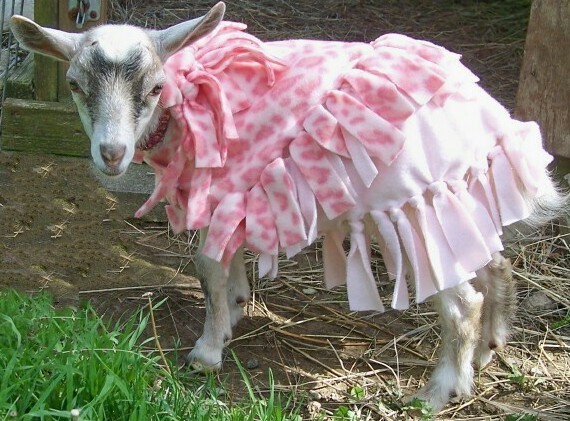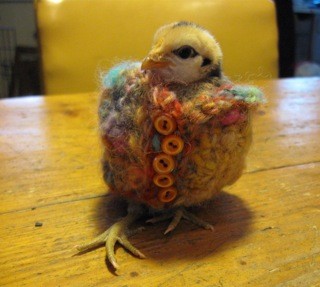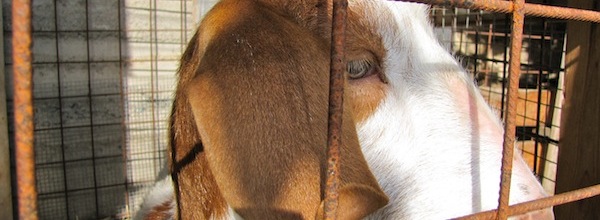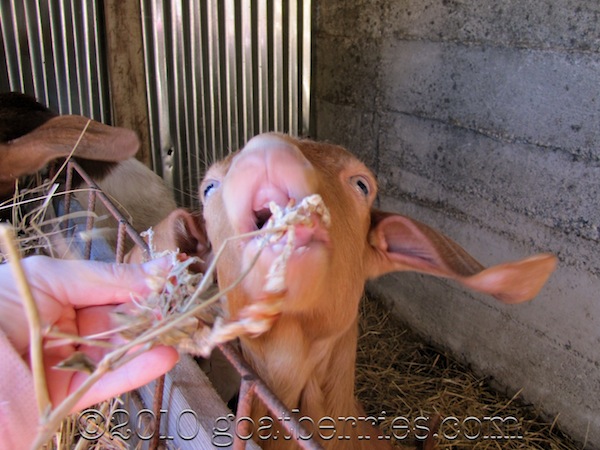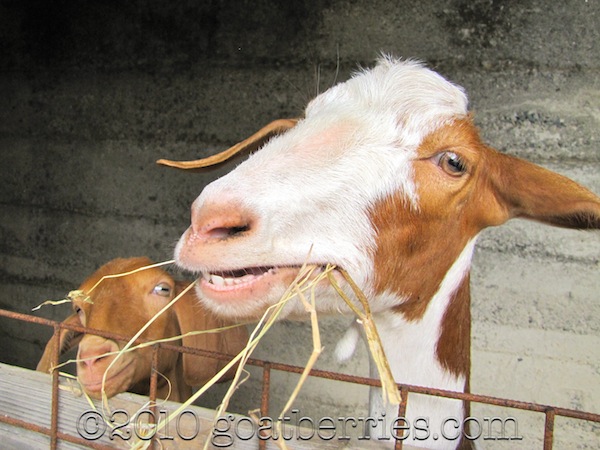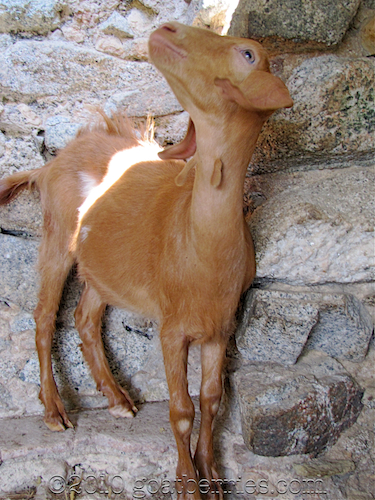Archive for the ‘Goat Basics’ Category
Horns or No Horns on Goats — Which is Better?
Faithful reader Renee posed a question on the Goat Berries Facebook page recently: What do we goat people feel about horns? I thought this was a great question for discussion, so I’m posting it here — please do add your thoughts on the issue as it can help other goat people make some tough decisions.
First, for anyone who doesn’t know, horns don’t go by sex; that is, you both females and males may have horns. It is a genetic trait (kind of like those adorable wattles), so if you’re breeding goats with horns, you’re probably, although not definitely, going to end up with kids with horns.
My girls are both naturally polled (born without horns), so the horn issue isn’t something we dealt with directly *but* we did aim for hornless, so I suppose you can say that I’m on the “no horn” side –beautiful as they can be. Just look at this dude:
From what I’ve read, anecdotes about how dangerous horns can be were the most persuasive to me. Goat horns can be dangerous not only for the goat caretakers and their families but also for fellow goats and other animals; goats do tend to headbutt in play and sometimes aggression and can do serious damage to others in either case.
Then there’s the possibility of the horns getting stuck in fences, etc., and putting the goat in other compromising positions, which can not only cause stress and difficulty in freeing itself (the goat can do major damage and even kill itself trying to get free), but it can also leave him or her exposed to predators — even a dog can kill a goat if it really wants to.
On the flip side, some people argue that disbudding is inhumane and unnatural as horns are goats’ natural defenses and help them cool off as sweat glands.
There’s a good discussion of this issue from a long-time goat caretaker at Fias Co. Farm, so I highly recommend heading over there for more information on this as well as on proper disbudding procedures. For the uninitiated, “disbudding” is the process of removing goat’s horns and really isn’t for the faint of heart — and quite painful for the kids too. Note that you should disbud within the first week of the kid’s life, so if you’re about to have kids, this is something you should think about sooner rather than later so you’re prepared.
For our goat-raising situation, I’d say disbudding would be best for us if faced with the horn dilemma — but this is a personal decision, of course, and I’d love to hear your take on it.
So, goat peeps, what is your position on horns? Do you goats have horns? If your goats get disbudded, do you do it yourself? Also, are your goats mixed — some polled, some horned? How does that work out?
Goat Coats and Other Regretsy Fun
My friend Rebecca who runs Brigolante Guest Apartments in Umbria, Italy and also writes a wonderful blog recently sent me a link to this entry on Regretsy:
Yes, that’s a goat coat made of “Pink Leopard fleece with contrast pink fleece. Fringed edges, velcro closures at neck and tummy.” It’s already been sold, but you can get the pattern if you’d like to make one yourself. Indeed, Furbabies Boutique has quite a few rather adorable sewing and crochet patterns — and not just for animal clothes but also fun socks, which actually make me want to learn to crochet.
Regretsy exists to poke fun at some of the items for sale on Etsy, but in all seriousness, if I lived in a colder climate, I’d put coats on my goats too — I don’t know that I’d go pink leopard fleece, but Clowee the pygmy in the photo really works it! I just don’t know if my girls are *that* into pink.
Now ponchos for chicks? Those I’m not so sure about….
Do your goats wear coats?
Can you recommend goat coats for other readers who might be in the market (and not looking to sew)?
How to Tell if Your Goat Is in Heat
If you have a doe that’s eight months old or older and it’s, say, October to January and you’re in the Northern Hemisphere, your crying goat just may be looking for a little love.
Read on...Raising Goats from the Teeth Up
People who aren’t familiar with goats are sometimes afraid they’re going to bite them, which is a rather baseless fear not only because goats are generally some of the least aggressive animals around (headbutting aside) but also because they have no top front teeth.
See those gorgeous gums? That’s all they have up there — just a dental pad.
They do have bottom teeth in the front, however.
When a goat is full grown, he or she will have eight incisors (biting or cutting teeth), all permanent teeth. Just like humans, though, they start out with baby teeth, so to speak. A kid has all small, sharp teeth for about a year. When the kid is about a year old, the center two teeth go bye-bye and are replaced by two permanent teeth. Then about every year or so after that, two teeth moving away from the center teeth on either side are replaced with permanent teeth until the goat has all eight permanent incisors by about four or five years old.
At that point, the teeth start to space apart, and you can begin to tell the age of the goat by the wear and tear on the teeth as opposed to the number of permanent versus baby teeth.
So does all this mean you can’t really be harmed by a goat’s teeth? Not exactly.
They *do* have 24 molars for chewing their cud in the back of their mouths — six on each side, upper and lower. And they are sharp as all get out, so you don’t want to be sticking your fingers toward the back of a goat’s mouth.
In other words, although it’s quite cute to see and feel the lil’ baby goats gnawing on the tip of your finger between their incisors and dental pad, once they start shifting that head to get your finger to the back of their mouth, you *must* get out of there, lest you become the cud.
Just trust me on that one, mkay?
More Goat Questions Answered!
It’s time again to talk about some of the searches that have brought people to Goat Berries. Read previous entries at Answering Goat Questions: Part I and Part II.
As I mentioned before, goats and watermelons have been on a lot of goatie friends’ minds these days, but here’s what else they’ve been wondering about:
1. Goats fig leaves edible : I’m assuming this is asking whether goats can eat fig leaves. Mine have, although we were told by a an experienced goat herder here that they shouldn’t have too much, so we tend to give them to our girlies just when we’re pruning the fig trees a bit — they never get more than a few branches at a time, and that’s usually weeks or months apart.
2. Goats and pit fruit / can goats eat fruit with seeds/pits : They sure can, and many times they’ll just spit the pit out if they don’t want it. Pasqualina has spit out both apricot and plum pits. It’s *so* fun to watch them eat these as they roll them around in their mouths. That said, don’t give them too many at a time — just like our digestive systems don’t love too much of a good thing like apricots and plums, neither do theirs.
3. Can goats eat banana peelings? : Whoo boy, can they — and my girl Pasqualina *loves* them. Loves bananas too. The other does we had also loved both fruit and peel, but Pinta isn’t old enough to care yet, apparently. Again, though, everything in moderation!
4. Kid goat cries all the time / why does my goat cry : Dig if you will the pic-ture. Oh wait, that’s When Doves Cry. Anyway, this is a tough one and requires that you know your kid pretty well. Some kids are just loud and cry when they want attention or food or milk or all of the above. Generally it’s not a problem unless it sounds like the kid’s in pain.
Of course, my kid cries like she’s in pain when she’s bored, so even that’s not a reliable measure. Who her?
In short, I think the answer to the question is most likely the age-old one: because s/he can. But if the crying seems abnormal to you, do look for other signs of illness such as lack of appetite, bloating, and just otherwise not doing goat-like things.
5. Milky sticky discharge coming out of nanny goat before kidding : Gross, but totally normal. We noticed it on two of ours about 24 hours before kidding. The other one didn’t show anything, or maybe we just weren’t looking (she was the first to go). I actually have a photo of this, but I think you get the idea; if you want to see it though, please feel free to contact me. In any event, you’ll be having a kid or more *very* soon. Congratulations!
Remember if you have any goat questions that aren’t answered somewhere in the blog, don’t be afraid to ask! I can’t promise to know the answer, but I will be happy to put it out there to other goatie lovers if I don’t.
And please feel free to add your bleats of wisdom on the above questions as well!
Buon weekend!
Reader Question: Double or Y-Shaped Teats
I got an email yesterday from a reader who has recently agreed to take on two kids (male and female) with the hopes of perhaps getting into small scale cheesemaking and soapmaking someday.
The rub is that they just discovered the little doe has Y-shaped teats. As there isn’t a whole lot of useful information out there on the Internet about this situation, I was wondering whether any of you with more goatie experience has some advice or info to share? The reader really wants to know whether it would still be a good idea to keep the little ones — perhaps pros and cons?
Any and all responses welcome! Thaaaaaaaanks!
Also, if you have a goatie question they’d like to post to Goat Berries readers, please feel free to contact me!


